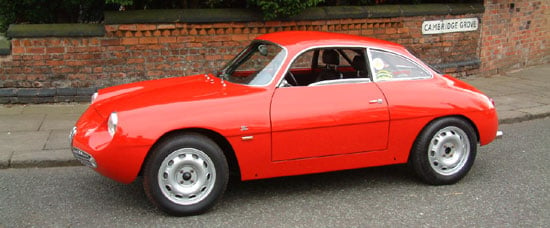
‘Gentleman driver’, ‘Mille Miglia’ and ‘accident’ are three phrases that often go together and indeed it was the results of a serious mishap that befell one Dore Leto di Priolo in the 1956 event, while driving his Giulietta Sprint Veloce, that led to the delightful series of small engined lightweight cars to come from the collaboration of two Milanese companies, Alfa Romeo and Zagato, in the early sixties.
Although many enthusiasts are familiar with the later racing TZ1 and TZ2 Alfa Romeos, few may realise the idea was born in 1956 when the destroyed Sprint Veloce was taken to Elio Zagato, with the aim of rebuilding the wreck as light as possible, with a totally new, more aerodynamic, body. The result was a car that was very similar to the one shown here, (a genuine SZ from later production), but with the legendary Zagato ‘double bubble’ roof. Known as the SVZ the car formed the basis of a small run of standard Giuliettas returning to Zagato for modification in order to beat the heavier, production model on the track. The engineers at Alfa and Bertone, who designed the standard car’s body, were not exactly enamoured with Zagato’s efforts, feeling it was taking sales away from their cars. To this end the company produced its own special body – the 1957 ‘Sprint Speciale’ or ‘SS’. Ironically this was to be the way both Zagato and Alfa would get together in 1960 to produce the SZ – a works sanctioned race and rally car.
Making its debut in Geneva on March 3rd 1960 the new little car caused an instant sensation. Based on the chassis of the ‘SS’ production car, itself having a shorter wheelbase than the old Sprint Veloce, the shape was the familiar rounded styling seen on the racetrack in the last couple of years, clothed in hand beaten, all-aluminium bodywork. Having built up their relationship with Alfa, Zagato were now delivered bare chassis to work on, rather than stripping down complete cars. 300 hours per car is quoted as being the time it took to fabricate a complete body – unthinkable nowadays. The 1300cc engines were tuned, and then tuned again to within an inch of their lives by such as experts as Conrero to produce over 130bhp – 100bhp per litre. The result was a purpose made customer race car for Alfa Romeo, leaving them to sell the Giulietta in quantity and cater for the well-heeled European set with their own SS, itself now becoming a luxury GT car.
The cars battled valiantly for class honours in the big events such as the Tour de France, Targa Florio, Sebring and the Nurburgring, as well as running in their own national races for small capacity machines. Drivers such as Biscaldi, Abate, Facetti and Elio Zagato himself in races, and the great Jean Rolland in rallying, all cut their teeth in the little cars before moving on to big capacity machinery from Ferrari and Porsche.
With principal class opposition coming from the British Lotus Elites, who could count on Jim Clark, Sir John Whitmore and a very useful Colin Chapman on the driving staff, Zagato later introduced a modified body on the same chassis - the Kamm tailed version - which was lower, longer and heavier; but faster in top speed, due to the improved aerodynamics. The die was set; the future was to be pure racing machinery with no compromises to road use. The superseding TZ1 model had the road chassis of the SZ replaced with a tubular spaceframe, and an even more radical body and highly tuned motor, whilst the TZ2, a ‘Junior GTO’ if you like, was the most extreme of the series.
The original car, the result of Elio Zagato’s genius meeting the consequences of the toughest road race in Italy, was the purest looking of all.
The facts – Alfa Romeo SZ – Round tail 1960-1963
Engine – 4 cylinder 1290cc. 74 x 75 mm bore/stroke. 9.7:1 compression ratio. Light alloy with cast iron liners
Max power – 100bhp @6500 rpm. Note extreme tuning will result in over 130bhp.
Gearbox – 5 speed all synchro.
Chassis – unibody with steel platform.
Body – Two door all aluminium by Zagato.
Suspension – Front; independent, wishbones, coil springs and telescopic shock absorbers.
Rear; ‘live’ axle with telescopic shock absorbers and coil springs.
Steering – worm and roller
Brakes – four wheel hydraulic drums.
Original price – 2,750,000 lire
With grateful thanks to H&H Auctions who sold this particular car at their inaugural London Auction on May 7th.
 |
 |
 |
 |
Text - by Steve Wakefield


